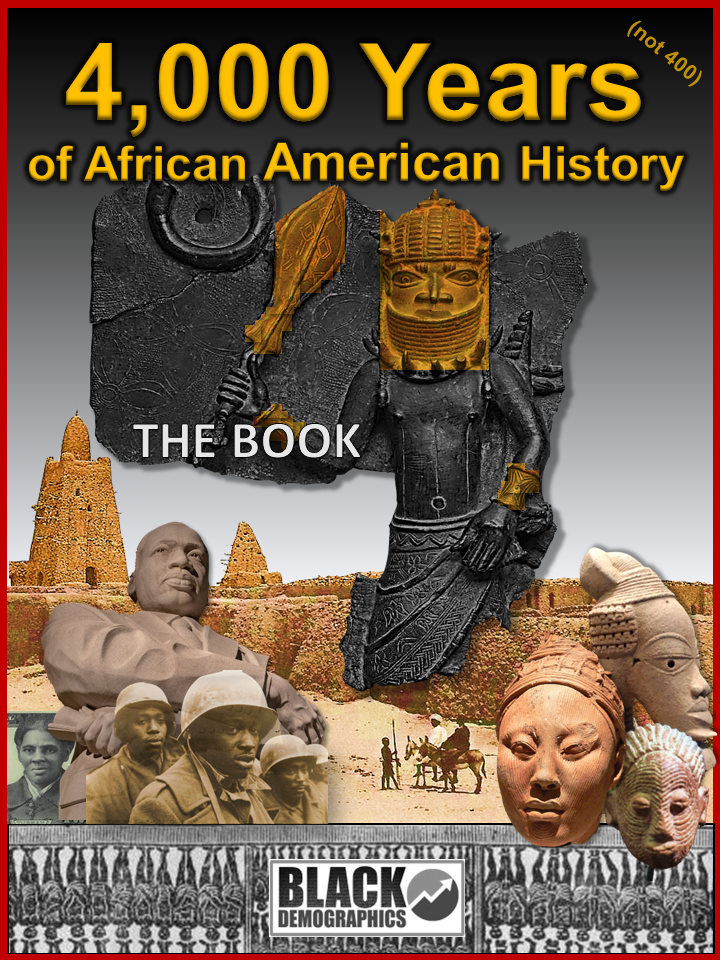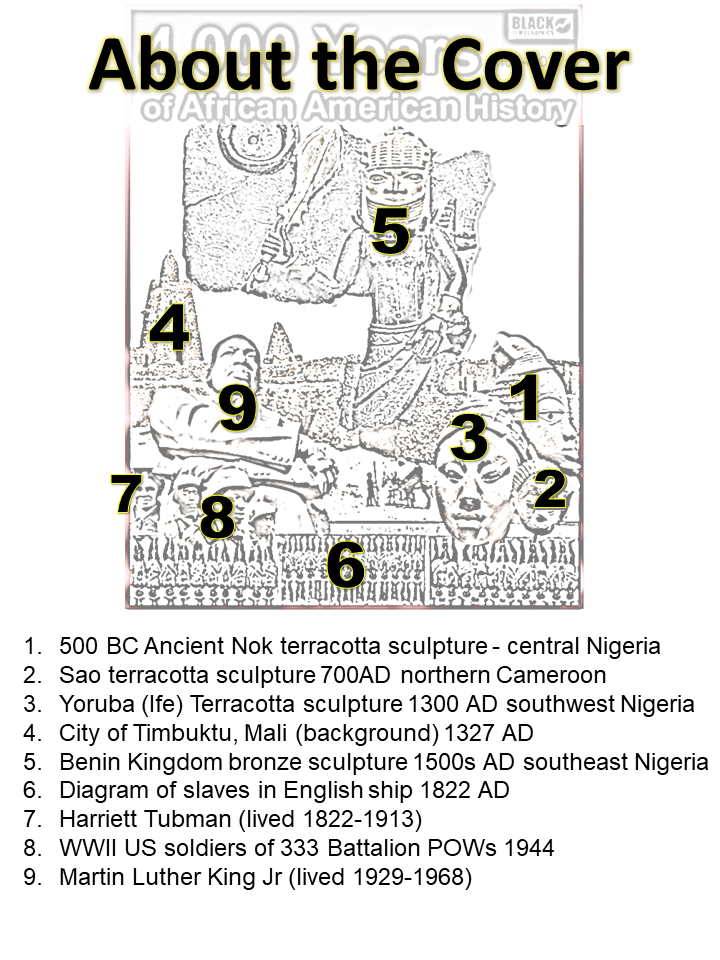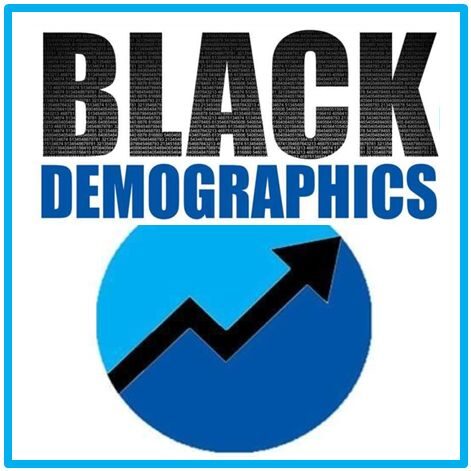THE BOOK: 4,000 Years of African American History – Download Pre-Order Chapters Today
Get Your Digital Copy of Our Next Big Project


[purchase_link id=”12012″ text=”Donate and Download Now” style=”button” color=”blue”]
Donate $16 to this project and immediately download the first 8 chapters
You will also get a free digital copy when it is complete
Your donation will help fund the completion of this project by its deadline. It takes a lot of man hours to put 2 years of research together into one book. Other costs include image rights, editing, and publishing fees.
All credit card transactions are handled by PayPal. Blackdemographics.com has no access to your credit card details. We will only have your name and email to send you the book link in the receipt.
Scroll down for a detailed outline.
See What’s in the Book Below
4,000 Years of African American History
INCLUDED IN TODAY’S DOWNLOAD
4,000 Years of African American History
📚 A Powerful Journey from 2000 BC to Today
Our history is deeper than slavery. It stretches across centuries, kingdoms, and continents.
🌍 Introduction: Reconnecting with Africa
- Why American education often overlooks Africa—especially the regions most African Americans come from
- How European history has been widely taught while African history remains in the margins
- Why Afrocentric focus on Egypt missed the stories of West Africa
- Two key takeaways:
- West Africa’s past is well-documented through oral tradition, written chronicles, and archaeology
- Its history shows long-standing political, economic, and cultural development
⚱️ Part I: Ancient Africa — Foundations & the Gold Empires
🏛 Chapter 1: The Road to Empires
- Early Civilizations:
- Gao (2000 BC), Djenne-Jeno (250 BC), Lake Chad city-states (500 BC)
- 🌾 Tichit & Walata (2000–500 BC): Farming societies with stone architecture and ironwork
- 🌍 The Big Dry: A centuries-long climate shift leading to mass migration
- 🏞 Mema (500 BC – 800 AD): A new home where Mande-speaking cultures expanded
- ⚒ Djenne-Jeno: A regional hub of trade and metalworking along the Niger River
👥 Mande Society Takes Shape
- Extended families formed the heart of communities
- Leadership by elders and consensus-building in villages
- Larger alliances created kingdoms with checks on royal authority
✝️ Mande Traditional Beliefs
- Belief in a supreme creator and lesser spirits who interact with the world
- Ancestors serve as spiritual guides
- Nyama: A life force connected to certain trades and traditions
🧬 Social Structure
- 👑 Land Nobles: Managed land and military service
- ⚒ Trade Guilds: Blacksmiths, hunters, musicians, historians (griots)
- 🧹 Servant Classes: Bound by duty or debt, with varying rights and statuses
🏜 North Africa & Trade Across the Sahara
- Berber traders connected North and West Africa
- Camels replaced horses, opening up desert trade
- Salt and gold trade routes became economic lifelines
🏆 Chapter 2: Ghana Empire (300–1200 AD)
- Mande Soninke people gain control of gold routes
- Salt and gold exchanged through vast desert networks
- Capital city Kumbi Saleh: Home to Muslims and traditional Mande groups
- Ghana’s kings taxed trade and protected merchants
- Arab historians described its wealth, government, and cultural life
🗣 The Griot Tradition
- Oral historians who memorized generations of stories
- Advisors, musicians, and keepers of royal memory
- Passed down knowledge through voice, rhythm, and song
- Cultural roots seen in the style of African American orators, poets, and preachers
🕌 Takrur: Ghana’s Neighbor and Islamic Rival
- Embraced Islam early, boosting trade alliances
- Fulani herders and Atlantic speakers shaped its identity
- Coexisted with Ghana but sometimes competed for influence
⚔ Historical Perspective
While Viking raids changed Europe, West Africa was also evolving—through trade, urban growth, and regional kingdoms.
👑 Chapter 3: Mali Empire (1200–1670 AD)
- Ghana fades, Mali rises
- Sumanguru Kante: Blacksmith-king whose rule became oppressive
- Sundiata Keita: Leader who united Mande kingdoms and restored stability
📜 The Manden Charter (1235 AD)
- One of the earliest known declarations of human rights
- Set guidelines for governance, land use, and fair treatment of people
- A framework for law and justice grounded in African traditions
🌍 Mali’s Golden Era
- Mansa Musa spreads Mali’s fame across the Islamic world
- Timbuktu becomes a major center for scholarship and trade
- Djenne thrives as a manufacturing hub
- Gao grows into a military and administrative capital
📖 What’s Ahead in the Book: A Preview
Songhai Empire (1375–1591 AD)
- Sonni Ali & Askia the Great expand trade, infrastructure, and power
- Advances in taxes, military, and administration
Senegambia
- Cultural crossroads of Mande, Fulani, and Atlantic traditions
Europe Reaches West Africa
- Portugal’s arrival after the fall of Constantinople
- Papal blessing for conquest and trade
- Moroccan invasion of Songhai (Battle of Tondibi)
Slavery and West African Kingdoms
- Servitude already existed — but changed drastically under European pressure
- Firearms escalate internal wars
- Kingdoms align and compete for access to European goods
Bambara Empire (1712 AD)
- Return to indigenous Mande traditions
- Resistance to Islamic theocracies and external control
Upper Guinea and the Rise of Islamic States
- Jihads and new religious states shape slave exports
The Akan Kingdoms of the Ivory & Gold Coasts
- Bono (1000 AD) and the gold trade
- Rise of Asante (1701 AD) and regional military power
- Complex systems of matrilineal inheritance and social roles
The Kong Empire (1710 AD)
- Multi-ethnic trade empire in present-day Côte d’Ivoire
🏞 Part 2: Nigeria and the Lake Chad Kingdoms
Ancient Northern Nigeria
- Gajiganna, Sao Civilization, Kanem-Bornu Empire
- Trade, religion, and the spread of Islam
Hausa Kingdoms
- Walled cities and regional specialization
- Fulani migrations reshape politics
Central & Southern Nigeria
- Nok Culture: Early ironwork and terracotta art
- Yoruba Kingdoms: Ife and Oyo — urban planning, trade, and monarchy
- Igbo Societies: Decentralized democracies and religious leadership
- Dahomey & Aro Confederacy: Rise of warfare, gun trade, and slave economies
🌍 Part 3: Congo–Angola Kingdoms
- Bantu migrations and cultural foundations
- Kongo Kingdom: Christianity and early diplomacy with Europe
- Queen Nzinga: Resistance to Portuguese invasion and slavery
🚢 Part 5: The Middle Passage (1500–1820 AD)
- Coastal regions involved in the Atlantic slave trade:
- Senegambia, Gold Coast, Bight of Benin, Congo-Angola
- Captives arrive in North America with diverse cultures and skills
🇺🇸 Part 6: Slavery in North America
- Enslaved Africans’ contributions to labor, culture, and resistance
- Formation of African American music, religion, and oral tradition
- Expansion of slavery through cotton and the Southern economy
🏃🏾♀️ Part 7: Emancipation & the Great Migration
- Reconstruction and rise of Black institutions
- Blues, gospel, and jazz take root
- Black towns like Mound Bayou and the Harlem real estate boom
- Caribbean immigration adds new layers
🏙 Part 8: The Second Great Migration (1941–1970)
- WWII creates jobs — and housing crises
- The Civil Rights era, Vietnam, and urban transformation
- Black economic gains meet systemic barriers
🏠 Part 9: The New Great Migration (1970–2000)
- Hip hop becomes a cultural voice
- Incarceration and the war on drugs reshape families
- Rise of the Black middle class and return to the South
📉 After 2000: Progress & Pressure
- Recession hits Black wealth hardest
- Gentrification and declining political influence
- Rise of Black-led activism and economic empowerment
🔚 Conclusion: African America — A Nation Within a Nation
This is the story of a people who came from kingdoms, endured slavery, built communities, and shaped a nation. The journey is long, but the roots run deep.
